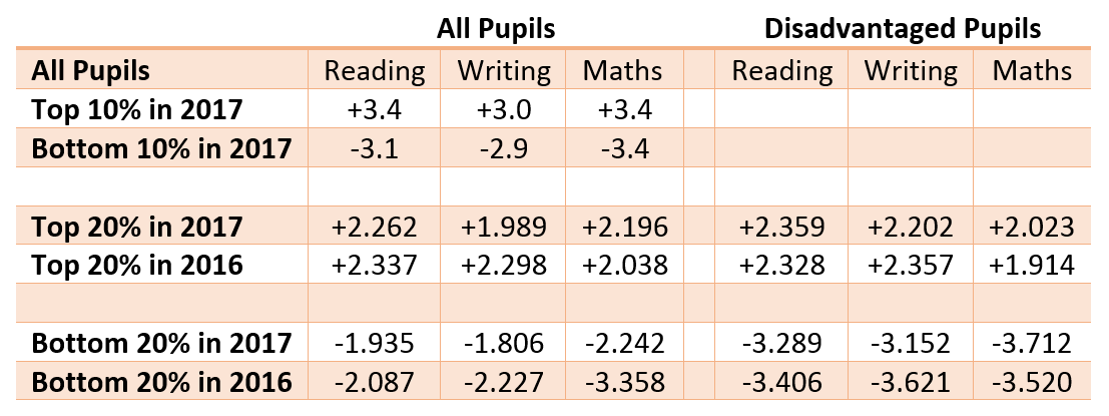
This series of articles will be looking at Ofsted’s Inspection Data Summary Report (IDSR).
In previous articles, we have looked at other pages in Ofsted’s Inspection Data Summary Report (IDSR).
In this article, we’ll look at the first page, “Areas to investigate”.
In 2016, this used to be called “Strengths and Weakness”, but is basically the same thing, categorized by Key Stage.
Early Years and Phonics
In 2017 there were no “Areas to Investigate” regarding Early Years, either the Good Level of Development or Early Learning Goals (despite there having been 2 Strengths and 1 Weakness in 2016).
In 2017 there were 3 Areas to Investigate regarding Year 1 Phonics (90% or above, below 70%, and if more than 10 pupils do not pass), and none regarding Year 2 Phonics.
Key Stage 1
For Key Stage 1, the following can be included in your “Areas to Investigate” for maths, reading or writing (note: not science):
 Attainment in SUBJECT was
Attainment in SUBJECT was
- above average and in the highest 10%.
- below average and in the lowest 10%.
- at or above national for the disadvantaged group.
- SUBJECT was in the bottom 20% for at least two years for all pupils/disadvantaged pupils.
For Key Stage 1, we are looking at attainment only for all pupils and disadvantaged pupils – so, none of this Emerging, Expected and Exceeding analysis here.
What is basically means is this:
- was your overall attainment in the 90%s, 80%s, or in the low 60%s-50%s or below?
- was your attainment of your disadvantaged pupils in the 40%s for Reading and Maths, or below about 33% for Writing?
Key Stage 2

For Key Stage 2 attainment, the following can be included in your “Areas to Investigate” for maths, reading or writing (not GPS or Science):
- SUBJECT attainment of the expected standard was at or above national for
- all prior attainment groups
- Prior attainment groups: low, middle, high
- at or above national for disadvantaged pupils
- SUBJECT attainment was in the bottom 20% for at least two years
- for all pupils.
- for disadvantaged pupils.
Information about the top and bottom 10% and 20% are shown in the table.

For Key Stage 2 progress, Ofsted comments for the following for maths, reading and writing in your “Areas to Investigate”:
- Progress in SUBJECT was significantly above average and in the highest 10% – in other words, were you “well above average”?
- Progress in SUBJECT was significantly below average and in the lowest 10% – in other words, were you “well below average”?
In other words, was your progress above +3.0 to +3.4, or below -2.9 to -3.4, as well as being significantly above/below average.
Additionally, when looking at 2 years, Ofsted analyses the following, where there are at least 6 pupils in a particular cohort in each year
 Mathematics/reading/writing progress was in the top/bottom 20% for at least two years for
Mathematics/reading/writing progress was in the top/bottom 20% for at least two years for
- all pupils
- low prior attainers
- middle prior attainers
- high prior attainers
- disadvantaged pupils
In other words:
- was your progress above +2.4 or so, or below around minus 2?
- But note that for disadvantaged pupils the figure is around -3, and
- for Low Prior Attainers it’s around +4.5 and -4.5.
Please see the tables for more details.
In 2017, Ofsted have tried to identify progress outliers:
- In 2017, there was one/two… negative outlier(s) in mathematics/reading/writing. This had an impact of #.# on the average progress score.
Please see our article on Key Stage 2 Scattergraphs for more details about outliers. It is unlikely that this will be used in 2018, due to changes in calculating progress.
Less often used, Ofsted can also comment on the following:
- Writing teacher assessments appear unusually high in this school compared with reading and mathematics. This trend is also seen in x local authority.
- Mathematics/writing/reading progress for SEN support was significantly* above/below the national for all pupils over the last two years. We have not seen this actually have been used.
- KS2 attainment was higher than average but progress was significantly lower than average. Progress data should be treated with caution (junior schools only.)
Attendance and Persistent Absence
In the “Areas to Investigate”, Ofsted comment on the following with regards to attendance and persistent absence:
- Attendance was high/low (in the highest/bottom 10% of all mainstream/special schools nationally). Basically, this is above 5.1% or below 2.9%.
- Attendance was above average.
- No group had low attendance (in the lowest 10% of all mainstream/special schools nationally).
- Attendance was low for the group(s): FSM /non-FSM /boys /girls /SEN with statement /SEN without statement /no SEN (in the lowest 10% of all mainstream /special schools nationally).
- Persistent absence was below average.
We hope that you have enjoyed this series of articles.
This FREE training course is also Available for FREE as a video learning course on our YouTube Channel.
- Learn at your speed (can be paused and restarted)
- Use on the go (over internet)
- Great for School Governors and School Leaders
